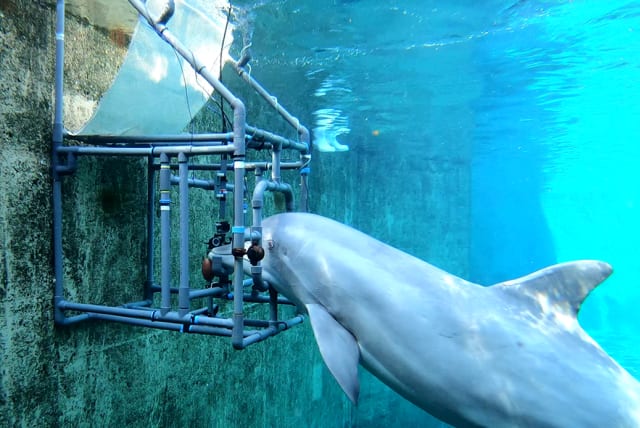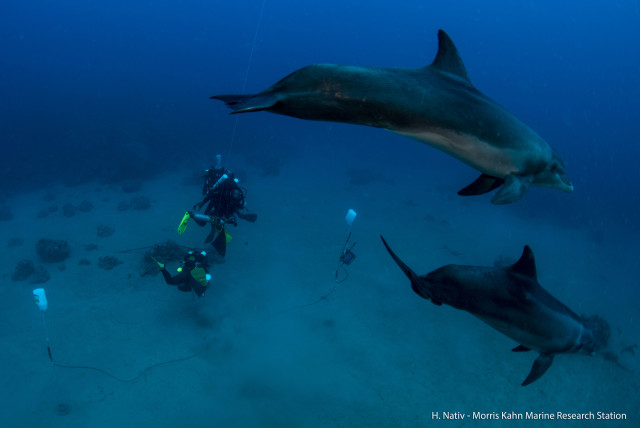Impact of ship noise on dolphins identified for first time with help of AI - Israeli study

Using AI, they were able to show that dolphins communicate in a unique way when ship noise is nearby.
With the large increase in human marine activity, our seas have become populated with vessels that can be overheard from distances of even 20 km. Until now, studies showed that such a dense presence of vessels impacts the behavior of marine animals – and in particular dolphins.
While previous explorations were based on a linear observation for changes in the features of dolphin whistles, non-linear responses of bottlenose dolphins have now been investigated. The noise from ships affects dolphins – one of the world’s most intelligent mammals – according to a study conducted at the University of Haifa that was based for the first time on artificial intelligence.
The research headed by Prof. Roee Diamant and Dr. Aviad Scheinin and colleagues at the university’s Charney School of Marine Sciences has just been published in the prestigious journal Scientific Reports of the Nature Group under the title “Observational study on the non-linear response of dolphins to the presence of vessels.”
“Although it seems obvious, until now there was no empirical evidence that dolphins are affected by ship noise.”
The unique communication of dolphins
Using AI, they were able to show that dolphins communicate in a unique way when ship noise is nearby.
“The influence of ship noise on communication between dolphins can cause them to move away from noise sources, which in some cases are their feeding grounds,” the authors explained.
The researchers combined acoustic studies of dolphin whistles (the form of communication used by the mammals) with AI software that searched for patterns in the cries.
One of the main problems with studies of this type is observing these mammals’ behavior, firstly when there is no ship noise and secondly when there is. This is the only way to determine whether the same dolphin behaves differently in each case. For this purpose, the researchers chose a location close to the dolphin reef in Eilat where common bottlenose (Tursiops truncatus) dolphins are regularly found.
Recording devices placed at a depth of 50 meters continuously recorded the sounds of nearby dolphins and shipping noise. From all the recorded sounds, the researchers filtered out 12,000 dolphin whistles and were able to assign them to the dolphins that were at that location. The algorithm developed by the researchers identified around 60,000 dolphin whistles when a ship was nearby, and the same number of whistles were identified when no ships were present.
“Maritime traffic has a very strong impact on the environment and public health in general and on the marine environment in particular, and is a factor that motivates the migration of species from one marine environment to another,” they continued. “Until now, it was not known whether dolphins were affected by ship noise; the evidence in this regard was mainly anecdotal and visual. The main difficulty is to systematically determine the behavior of dolphins encountering ship noise.”
According to Diamant, it was not visual inspection of the signals nor direct feature extraction that were able to distinguish between the two groups of whistles – with and without the presence of a ship. Instead, this was analyzed by a deep-learning algorithm.
This algorithm was trained over 20% of the whistle database and tested on the remaining whistles. The result was a 90% success rate in classifying between the two sets. In other words, the AI was able to recognize a certain pattern in the whistles of the dolphins exposed to shipping noise, well above the chance level.
The researchers understood from this result that a clear impact on the dolphins occurs when vessels were around. “The problem with deep learning is that it’s a kind of a ‘black box’; it’s hard to associate the classification result to a physical meaning within the signal. We still don’t know what unique pattern the AI system has recognized, but we know that it is related to the type of communication they make, and previous studies have already shown that changes in vocal behavior can be the result of stress and distress. In other words, dolphins communicate in a different way and change their vocal behavior when they encounter ship noise. In our upcoming studies, we will try to understand the nature of the effects,” the researchers concluded.
The current study, supported by the university’s Data Science Center, was conducted in collaboration between the Underwater Acoustic and Navigation Laboratory (ANL), headed by Diamant, and the Marine Apex predator laboratory headed by Scheinin.
The Environment and Climate Change portal is produced in cooperation with the Goldman Sonnenfeldt School of Sustainability and Climate Change at Ben-Gurion University of the Negev. The Jerusalem Post maintains all editorial decisions related to the content.
Jerusalem Post Store
`; document.getElementById("linkPremium").innerHTML = cont; var divWithLink = document.getElementById("premium-link"); if (divWithLink !== null && divWithLink !== 'undefined') { divWithLink.style.border = "solid 1px #cb0f3e"; divWithLink.style.textAlign = "center"; divWithLink.style.marginBottom = "15px"; divWithLink.style.marginTop = "15px"; divWithLink.style.width = "100%"; divWithLink.style.backgroundColor = "#122952"; divWithLink.style.color = "#ffffff"; divWithLink.style.lineHeight = "1.5"; } } (function (v, i) { });

